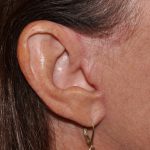Patients considering facelift surgery seek an improved neck and jowl line. Such surgery requires the use of incisions around the ears to accomplish that goal. Patients are understandably concerned about the location of the scars, but once explained where they will lie, are reassured that they will not be noticeable to the general public. However, one’s hairdresser will be able to find them because they do potentially disrupt the temporal and occipital hairlines.
One of the most important keys to a ‘good’ facelift is avoiding visible scars and not changing or altering the hairline around the ears. The two locations of hairline disruption are the temporal (sideburn) and occipital (behind the ear) areas. The hairline above the ear is never disrupted as this is not where any facelift incision would usually go.
One of the most common potential hairline problems is loss of the temporal tuft or sideburn hair. This is a problem best avoided as there is no simple correction of a sideburn tuft that has been raised into the temporal area. No female wants to undergo a facelift only to loss the option of wearing their hair up afterwards. The classic facelift incision in front of the ear goes up vertically into the temporal scalp hair. With this approach, the redraping or upward pull of the facial skin shifts the sideburn hair up higher. If one has a low enough sideburn tuft this may not be an issue. (most women do not have a low or long sideburn hair) But if the bottom portion of the tuft is just at the level of the attachment of the ear, its loss from the face will occur.

The other common hairline problem that occurs in many facelifts is that the skin redraping behind the ear alters the occipital hairline. This is the area where your hairdresser can potentially see that a facelift had be done. As the skin behind the ear is pulled up and back, a step-off or notch in the occipital hairline can occur as skin without hair replaces scalp hair. The key to this incision is to start its horizontal extension from the ear high (at the level of the ear canal) and then back into the occipital hair. When the postauricular skin is redraped it is pulled straight up and not back. This enables the occipital hairline to be maintained as the excess post-auricular skin is removed. When the incision is this high behind the ear, there is sufficient hair below the incision to adequately hide it.
While understandable focus in a facelift is on how the neck and jowl line looks, one of the keys to avoiding a telltale sign of having had a facelift is how well the hairline around the ear is managed. Preserving the sideburn tuft of hair and keeping a smooth unaltered occipital hairline are important finesse maneuvers of facelift design and execution.
Dr. Barry Eppley
Indianapolis. Indiana


